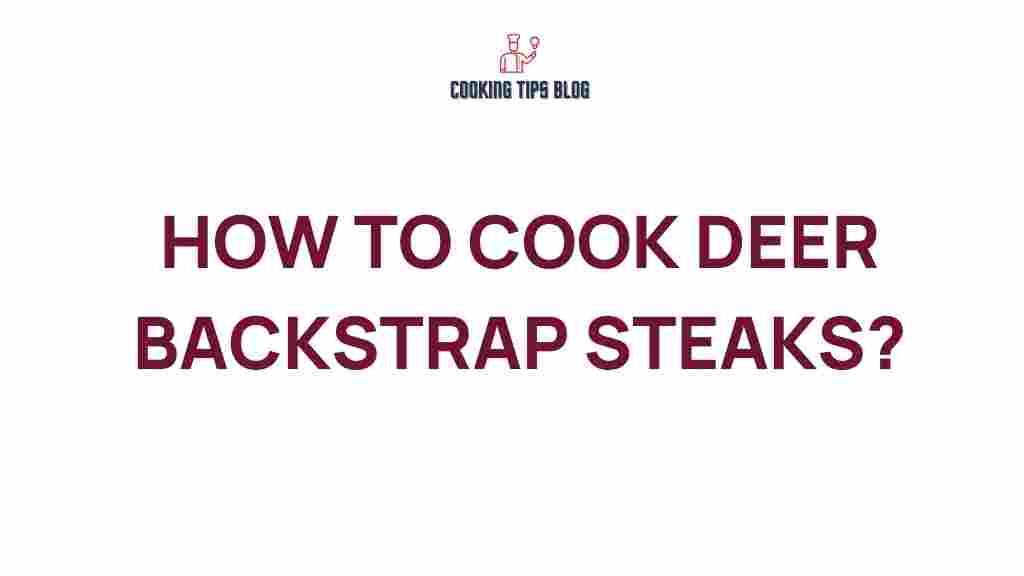Mastering the Art of Cooking Deer Backstrap Steaks
Cooking deer backstrap steaks is an exhilarating culinary adventure that showcases the incredible flavors of venison. Known for its tenderness and rich taste, the deer backstrap is a prized cut that any home chef should learn to prepare. In this guide, we will take you step-by-step through the process of cooking deer backstrap steaks, ensuring you master this delicious dish and impress your family and friends.
Understanding Deer Backstrap
Before diving into the cooking process, it’s essential to understand what deer backstrap is. The backstrap is essentially the muscle that runs along the spine of the deer. This cut is often compared to beef tenderloin due to its tenderness and flavor. Knowing how to prepare it properly will elevate your culinary skills and bring a gourmet touch to any meal.
Choosing the Right Deer Backstrap
When selecting deer backstrap, consider the following tips:
- Freshness: Look for bright red color with minimal dark spots.
- Fat content: Some fat is good for flavor, but you want to avoid excessive fat.
- Source: If possible, source your deer backstrap from a reputable hunter or butcher.
Preparation Steps for Deer Backstrap Steaks
Now that you have your deer backstrap, it’s time to prepare it for cooking. Follow these steps to ensure a delicious outcome:
1. Cleaning and Trimming
Start by cleaning and trimming the backstrap:
- Remove any silver skin or connective tissue with a sharp knife.
- Trim off excess fat, but leave some for flavor.
2. Marinating the Backstrap
Marinating adds flavor and tenderness to your deer backstrap. Here’s a simple marinade recipe:
- 1/4 cup olive oil
- 2 tablespoons soy sauce
- 2 tablespoons balsamic vinegar
- 2 cloves garlic, minced
- 1 tablespoon fresh rosemary, chopped
- Salt and pepper to taste
Combine all the ingredients and marinate the deer backstrap for at least two hours, or overnight for best results.
3. Choosing the Cooking Method
There are several methods to cook deer backstrap effectively:
- Grilling: Provides a smoky flavor and beautiful grill marks.
- Searing: A hot skillet can create a delicious crust.
- Roasting: Perfect for larger cuts or when cooking for a group.
Cooking Deer Backstrap Steaks
Once your deer backstrap is marinated and you’ve chosen your cooking method, it’s time to cook! Follow these detailed steps for each method:
Grilling Deer Backstrap Steaks
- Preheat your grill to high heat.
- Remove the backstrap from the marinade and let it rest for about 10 minutes.
- Season with additional salt and pepper if desired.
- Place the backstrap on the grill and cook for about 4-5 minutes on each side for medium-rare.
- Let it rest for 5-10 minutes before slicing.
Searing Deer Backstrap Steaks
- Heat a cast-iron skillet over medium-high heat and add a tablespoon of oil.
- Remove the backstrap from the marinade and let it rest for about 10 minutes.
- Season with additional salt and pepper.
- Place the backstrap in the skillet and sear for 3-4 minutes on each side for medium-rare.
- Allow it to rest for 5-10 minutes before slicing.
Roasting Deer Backstrap Steaks
- Preheat your oven to 375°F (190°C).
- Remove the backstrap from the marinade and season it with salt and pepper.
- In a skillet, sear the backstrap on all sides for 2-3 minutes.
- Transfer the skillet to the oven and roast for about 10-15 minutes for medium-rare.
- Let it rest for 5-10 minutes before slicing.
Tips for Perfectly Cooked Deer Backstrap
Here are some additional tips to ensure your deer backstrap is cooked to perfection:
- Use a meat thermometer: Aim for an internal temperature of 130-135°F (54-57°C) for medium-rare.
- Resting time: Always let your meat rest after cooking to allow juices to redistribute.
- Slice against the grain: This technique makes the meat even more tender.
Troubleshooting Common Issues
Even the best chefs encounter issues from time to time. Here are some common problems and how to solve them:
- Overcooked Backstrap: If you accidentally overcook your deer backstrap, consider slicing it thinly and serving it with a sauce to add moisture.
- Too Gamey: If the flavor is too strong, marinating for longer or using strong spices can help mask the gamey taste.
- Dry Texture: Ensure you’re not cooking at too high a temperature; lower heat can help retain moisture.
Serving Suggestions for Deer Backstrap Steaks
Now that your deer backstrap steaks are perfectly cooked, it’s time to serve them! Here are some delicious ideas:
- Pair with sides: Serve with roasted vegetables, mashed potatoes, or a fresh salad.
- Sauce it up: Consider a red wine reduction, mushroom sauce, or a simple herb butter.
- Wine pairing: A robust red wine, such as Cabernet Sauvignon, pairs beautifully with venison.
Conclusion
Cooking deer backstrap steaks is not just about the final product; it’s a culinary adventure filled with learning and creativity. By mastering this cut of meat, you can impress your guests and enjoy a delicious, high-quality meal right at home. Remember to experiment with different marinades and cooking methods, and don’t hesitate to explore new flavor combinations.
For more tips on venison cooking and hunting resources, check out Field & Stream. Happy cooking!
By following this guide, you’ll be well on your way to mastering the art of cooking deer backstrap. Enjoy the journey and the delectable results!
This article is in the category Recipes and created by Cookingtipsblog Team
